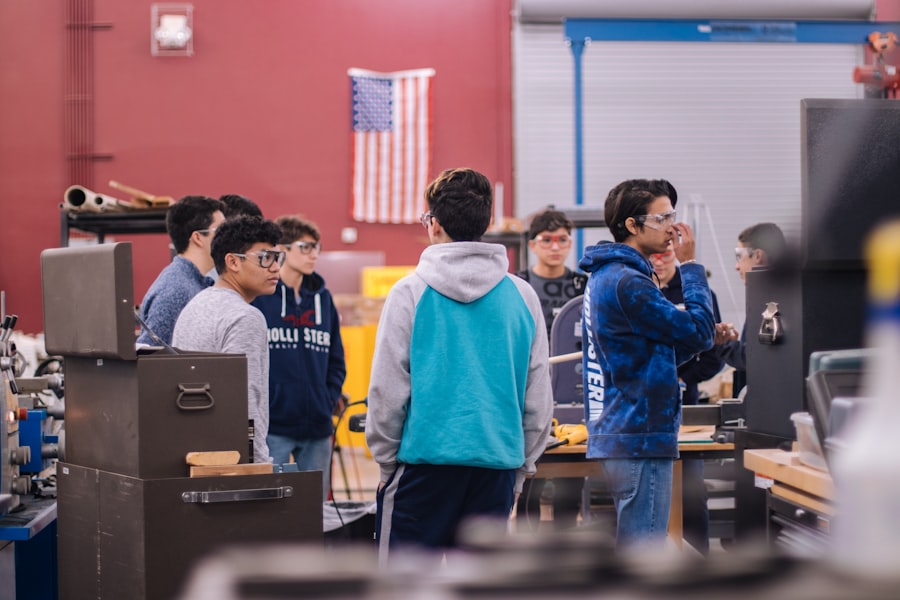The blended classroom model represents a transformative approach to education that combines traditional face-to-face instruction with online learning components. This hybrid model allows educators to leverage the strengths of both in-person and digital teaching methods, creating a more dynamic and flexible learning environment. In a blended classroom, students engage with course materials through various online platforms while also participating in direct interactions with their teachers and peers.
This dual approach not only caters to diverse learning styles but also fosters a sense of community among students, as they can collaborate and communicate both in person and through digital channels. At its core, the blended classroom model is designed to enhance the educational experience by integrating technology into the learning process. This integration can take many forms, from using online resources for research and assignments to employing educational software that tracks student progress.
The model encourages students to take ownership of their learning, as they can access materials at their own pace and revisit content as needed. Furthermore, teachers can utilize data analytics from online platforms to tailor their instruction to meet the specific needs of each student, making the learning experience more personalized and effective.
Key Takeaways
- The blended classroom model combines traditional face-to-face instruction with online learning, offering a flexible and personalized approach to education.
- Benefits of blended learning for students include increased engagement, personalized learning experiences, and improved access to resources and support.
- Blended learning enhances teacher effectiveness by providing opportunities for personalized instruction, data-driven decision making, and the ability to differentiate instruction to meet individual student needs.
- Strategies for implementing blended learning in the classroom include setting clear goals, providing professional development for teachers, and leveraging technology to support learning.
- Overcoming challenges in blended learning environments requires addressing technology issues, providing support for students and teachers, and creating a strong communication and collaboration system.
Benefits of Blended Learning for Students
Flexibility and Autonomy in Learning
Blended learning offers students a significant advantage in terms of flexibility. With access to online resources, students can learn at their own pace, allowing them to spend more time on challenging concepts while moving quickly through material they grasp easily. This self-directed approach not only fosters independence but also encourages students to take responsibility for their own learning journey.
Enhanced Balance and Well-Rounded Education
The ability to access course materials anytime and anywhere means that students can balance their academic responsibilities with extracurricular activities or personal commitments, leading to a more well-rounded educational experience. This flexibility allows students to manage their time more effectively and prioritize their responsibilities.
Engagement and Retention through Interactive Content
Blended learning environments also offer the opportunity for enhanced engagement through interactive and multimedia content. Unlike traditional classroom settings that often rely heavily on lectures and textbooks, blended learning utilizes videos, simulations, and interactive quizzes that cater to various learning preferences. This variety not only makes learning more enjoyable but also helps reinforce concepts through different modalities. As a result, students are more likely to retain information and develop a deeper understanding of the subject matter.
How Blended Learning Enhances Teacher Effectiveness

Blended learning significantly enhances teacher effectiveness by providing educators with a wealth of resources and tools to support their instruction. With access to online platforms, teachers can curate a diverse array of materials that align with their curriculum, allowing them to present information in innovative ways. This flexibility enables educators to differentiate instruction based on individual student needs, ensuring that all learners receive the support they require to succeed.
Moreover, teachers can use data analytics from online assessments to identify areas where students may be struggling, allowing for timely interventions and targeted support. Additionally, blended learning fosters collaboration among educators, as teachers can share best practices and resources within their professional communities. Online platforms often include forums or networks where educators can exchange ideas, strategies, and experiences related to blended instruction.
This collaborative environment not only enhances individual teaching practices but also contributes to a culture of continuous improvement within schools. As teachers become more adept at integrating technology into their instruction, they are better equipped to engage students and create meaningful learning experiences that resonate with today’s digital natives.
Strategies for Implementing Blended Learning in the Classroom
| Strategy | Description |
|---|---|
| Flipped Classroom | Students engage with instructional content outside of class and use class time for activities and discussions. |
| Station Rotation | Students rotate through different learning stations, including online learning, teacher-led instruction, and collaborative group work. |
| Flex Model | Students have control over the time, place, and pace of their learning, often with online learning as a component. |
| Online Lab | Students engage in online learning activities and experiments, with the teacher providing guidance and support. |
| Project-Based Learning | Students work on extended projects that integrate online and offline resources, with the teacher acting as a facilitator. |
Implementing blended learning in the classroom requires careful planning and consideration of various factors that contribute to its success. One effective strategy is to start small by incorporating blended elements into existing lesson plans rather than overhauling the entire curriculum at once. For instance, teachers can begin by integrating online resources for specific units or topics, gradually increasing the use of digital tools as they become more comfortable with the model.
This incremental approach allows educators to assess what works best for their students while minimizing potential disruptions to the learning process. Another key strategy involves providing professional development opportunities for teachers to enhance their skills in using technology effectively. Training sessions can focus on various aspects of blended learning, such as selecting appropriate digital tools, designing engaging online content, and utilizing data analytics for assessment purposes.
By equipping educators with the necessary knowledge and skills, schools can foster a culture of innovation and collaboration that supports the successful implementation of blended learning initiatives. Furthermore, involving students in the process by seeking their feedback on online resources and activities can help tailor the approach to better meet their needs and preferences.
Overcoming Challenges in Blended Learning Environments
Despite its many advantages, blended learning also presents several challenges that educators must navigate to ensure its effectiveness. One common obstacle is the digital divide, which refers to disparities in access to technology among students. Not all learners have equal access to devices or reliable internet connections, which can hinder their ability to participate fully in a blended classroom environment.
To address this issue, schools must prioritize equitable access by providing necessary resources or alternative solutions for students who may face technological barriers. Another challenge lies in managing the balance between online and face-to-face instruction. Teachers may struggle with determining how much time should be allocated to each mode of delivery while ensuring that students remain engaged and motivated throughout the learning process.
To overcome this challenge, educators can establish clear guidelines for online participation and set expectations for in-person interactions. Regular check-ins with students can also help gauge their understanding and engagement levels, allowing teachers to adjust their instructional strategies as needed.
Maximizing Student Engagement in a Blended Classroom

Creating an Engaging Blended Classroom
Maximizing student engagement in a blended classroom requires intentional planning and creativity from educators. One effective approach is to incorporate gamification elements into online activities, transforming traditional assignments into interactive challenges that motivate students to participate actively. By introducing game-like features such as points, badges, or leaderboards, teachers can create a sense of competition and achievement that encourages students to engage more deeply with the material.
Fostering a Sense of Community and Open Communication
This strategy not only makes learning enjoyable but also fosters a sense of community among peers as they collaborate and compete together. Additionally, fostering a culture of open communication is essential for maintaining student engagement in a blended environment. Teachers should encourage students to share their thoughts, questions, and feedback regarding both online and in-person components of the course.
Encouraging Peer-to-Peer Interaction and Collaboration
Creating opportunities for peer-to-peer interaction through discussion boards or group projects can further enhance engagement by allowing students to learn from one another’s perspectives. By valuing student input and promoting collaboration, educators can create an inclusive atmosphere that motivates learners to take an active role in their education.
Building a Supportive Learning Environment
By implementing these strategies, educators can create a blended classroom environment that is engaging, inclusive, and supportive of student learning. By prioritizing student engagement and motivation, teachers can help learners achieve their full potential and develop a lifelong love of learning.
Personalizing Learning in a Blended Classroom Setting
Personalizing learning in a blended classroom setting is one of its most compelling features, as it allows educators to tailor instruction based on individual student needs and preferences. By utilizing data collected from online assessments and activities, teachers can identify specific areas where students may require additional support or enrichment. This targeted approach enables educators to design customized learning pathways that align with each student’s strengths and weaknesses, ultimately fostering greater academic success.
Moreover, personalized learning encourages students to set their own goals and take ownership of their educational journey. In a blended environment, learners have the flexibility to choose how they engage with content—whether through videos, readings, or interactive simulations—allowing them to select methods that resonate with their unique learning styles. This autonomy not only boosts motivation but also cultivates critical thinking skills as students navigate their own paths toward mastery of concepts.
Assessing the Effectiveness of Blended Learning Approaches
Assessing the effectiveness of blended learning approaches is crucial for determining their impact on student outcomes and overall educational quality. Educators should employ a variety of assessment methods that encompass both formative and summative evaluations. Formative assessments—such as quizzes, discussions, or reflective journals—provide ongoing feedback about student understanding throughout the course, allowing teachers to make real-time adjustments to instruction as needed.
Summative assessments, on the other hand, evaluate student performance at the end of a unit or course, offering insights into overall mastery of content. In addition to traditional assessments, educators should consider incorporating self-assessment and peer assessment into their evaluation processes. Encouraging students to reflect on their own learning experiences fosters metacognitive skills and helps them identify areas for improvement.
Peer assessment promotes collaboration and accountability among classmates while providing diverse perspectives on individual performance. By utilizing a comprehensive assessment framework that includes multiple methods and sources of feedback, educators can gain valuable insights into the effectiveness of blended learning approaches and make informed decisions about future instructional strategies.
For educators looking to enhance their teaching methods by integrating technology with traditional classroom settings, a related article worth reading discusses the effectiveness of blended classrooms. This approach combines online digital media with traditional face-to-face teaching, aiming to provide a more personalized and flexible learning experience. You can read more about the strategies and benefits of blended learning in this insightful article at Blended Learning Strategies for Educators.
FAQs
What is a blended classroom?
A blended classroom is a learning environment that combines traditional face-to-face instruction with online learning activities. It integrates technology and digital resources into the curriculum to enhance the learning experience.
What are the benefits of a blended classroom?
Some benefits of a blended classroom include increased flexibility for students, personalized learning opportunities, access to a variety of resources and materials, and the development of digital literacy skills.
How does a blended classroom work?
In a blended classroom, students engage in a combination of in-person instruction, independent online learning, and collaborative activities. Teachers use a variety of digital tools and platforms to deliver content, assess student progress, and facilitate communication.
What are some examples of blended learning activities?
Blended learning activities can include watching instructional videos, participating in online discussions, completing interactive modules or simulations, and using educational apps or software. These activities are often supplemented with in-person discussions, group work, and hands-on projects.
What technology is used in a blended classroom?
Technology used in a blended classroom can include learning management systems, video conferencing tools, educational apps, digital textbooks, and interactive whiteboards. Students may also use devices such as laptops, tablets, or smartphones to access online resources and complete assignments.



